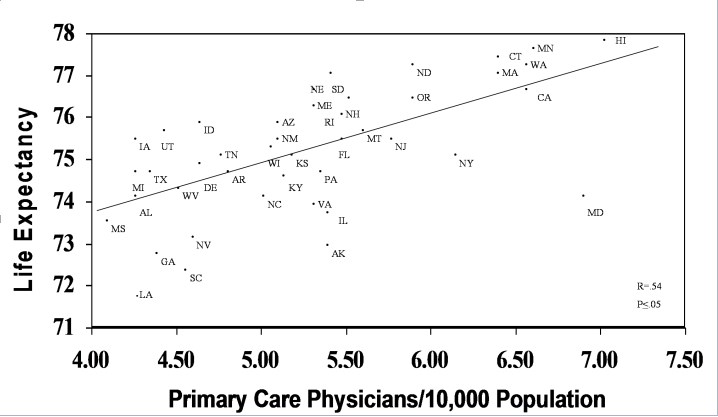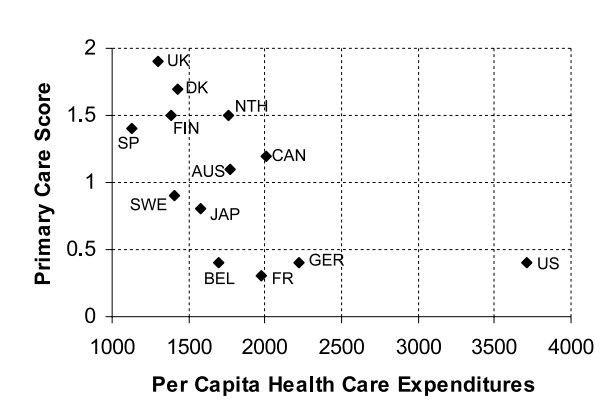An Introduction to Primary Care
The Institute of Medicine defines primary care as “the provision of integrated, accessible healthcare services by clinicians who are accountable for addressing a large majority of personal health care needs, developing a sustained partnerships with patients, and practicing in the context of family and community.” This definition highlights several key features of primary care:
Primary care and health outcomes
Better primary care leads to better health outcomes. This has been demonstrated across health care systems and across nations since the 1960s.
Barbara Starfield, a pediatrician and professor of health policy at Johns Hopkins, spent 20 years studying the impact of primary care. Her work “consistently showed that increasing the supply of primary care physicians, even after correction for socioeconomic factors, results in lower all-cause mortality; lower mortality from cancer, heart disease, and stroke; increased life expectancy and better self-reported health; lower rates of admission to hospital; lower infant mortality; reduced health inequalities; and reduced costs. Furthermore, she showed that relatively more medical specialists compared to primary care physicians resulted in greater costs and a trend towards an increase or neutral effect on overall mortality.” 5
Dr. Starfield and her team identified a series of characteristics of countries with better health outcomes. First, these countries have primary care-oriented healthcare systems. They have a more equitable distribution of resources, they have government-provided health services or insurance, they have little or no private health insurance, and they have little or no co-payments for health services..
In the graph below, countries are ranked on two axes. “System characteristics,” on the x axis, reflect the strength of health policies that support primary care, such as regulation of resource distribution and the relative compensation of primary care versus specialty physicians. “Practice characteristics,” on the y axis. reflect the quality of on-the-ground primary practice, including continuity, comprehensiveness, coordination & family centeredness. This comparison demonstrates how big picture policies impact the quality of practice on the ground.

Life expectancy is higher in US states that have higher primary care physician to population ratios. Each additional primary care physician per 10,000 population is associated with an average increase of about 2 years in life expectancy. Another study showed that American adults who called their personal physician a primary care doctor rather than a specialist had 33% lower cost of care and a 19 % lower risk of death.

Countries with a higher quality primary care system have significantly lower health care spending even if the United States, which is such a high-cost outlier, is removed from the analysis.
 In the United States, a study of Medicare beneficiaries in fair or poor health showed that one of the strongest predictors of a preventable hospitalization was living in a primary care shortage area. Areas with better primary care have better health outcomes including lower total, cardiovascular and infant mortality as well as earlier detection of colorectal, breast, uterine and cervical cancer.
In the United States, a study of Medicare beneficiaries in fair or poor health showed that one of the strongest predictors of a preventable hospitalization was living in a primary care shortage area. Areas with better primary care have better health outcomes including lower total, cardiovascular and infant mortality as well as earlier detection of colorectal, breast, uterine and cervical cancer.
There are always limitations in the evidence, and we can always ask more questions. Most of the evidence supporting primary care is ecological and observational, and it is hard to sort out the covariates, issues of causation, and determinants of health, all of which are extremely complex. Nevertheless, a large body of evidence supports the substantial impact of primary care on health.
Resources & References
Remember Barbara Starfield: primary care is the health system’s bedrock (BMJ 2013;347:f4627)
Preventable hospitalizations in primary care shortage areas. An analysis of vulnerable Medicare beneficiaries (Arch Fam Med. Nov-Dec 1999;8(6):487-91. doi: 10.1001/archfami.8.6.487.)
Quantifying the health benefits of primary care physician supply in the United States (Int J Health Serv. 2007;37(1):111-26. doi: 10.2190/3431-G6T7-37M8-P224.)
The role of primary care in early detection and follow-up of cancer (Emery, J., Shaw, K., Williams, B. et al. The role of primary care in early detection and follow-up of cancer. Nat Rev Clin Oncol 11, 38–48 (2014). https://doi.org/10.1038/nrclinonc.2013.212)
